1lumen selects and reviews products personally. We may earn affiliate commissions through our links, which help support our testing.
Microfire Excalibur H20 review

Specifications
| Brand/model | MicroFire Excalibur H20 |
|---|---|
| LED | Osram white flat W1 |
| Lumens | N/A |
| Beam intensity | 1,000,000 cd / 2,000 meters |
| Battery config. | Battery pack |
| Material | Aero-grade aluminum |
| Modes | 1 + dim |
| Blinkies | Strobe |
| Reflector | N/A |
| Water resistance | 5 m |
| Review date | November 2020 |
INTRODUCTION:
MicroFire initially tried to organize the Optispike S50 to review and return to the European dealer, but the European dealer was difficult to get ahold of. The headquarters of MicroFire sent me the MicroFire Excalibur H20 for review instead.
The Excalibur H20 is a long-range LED flashlight claiming 1 million candelas and a reach of up to 2,000 meters. It’s the highest quality ‘zoomy’ flashlight I have encountered. This is going to be my first MicroFire flashlight review, and so far, I’m really impressed.
But can it really reach that far?
Package quality.
You know that you get a quality product if it is delivered in a hard case with padding and a 12V power adapter. I’m not talking about low quality plastic cases, but a very rugged hard case. That caught me a little off guard, because I wasn’t expecting this kind of craftsmanship. Together with the H20, they included the Falcon H8, which I didn’t know was that small. That is going to be in another review.
- MicroFire Excalibur H20
- Hard case with lots of padding and carry strap
- Carry strap
- Quality Control sticker
- Manual on copy paper
- Lanyard, probably for the Falcon H8
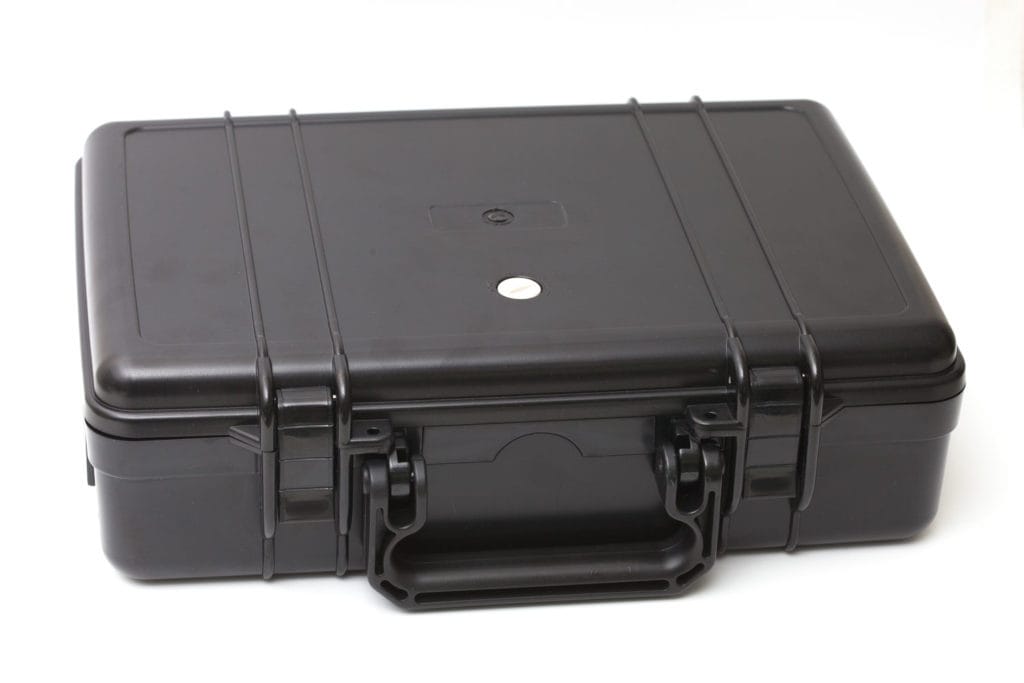

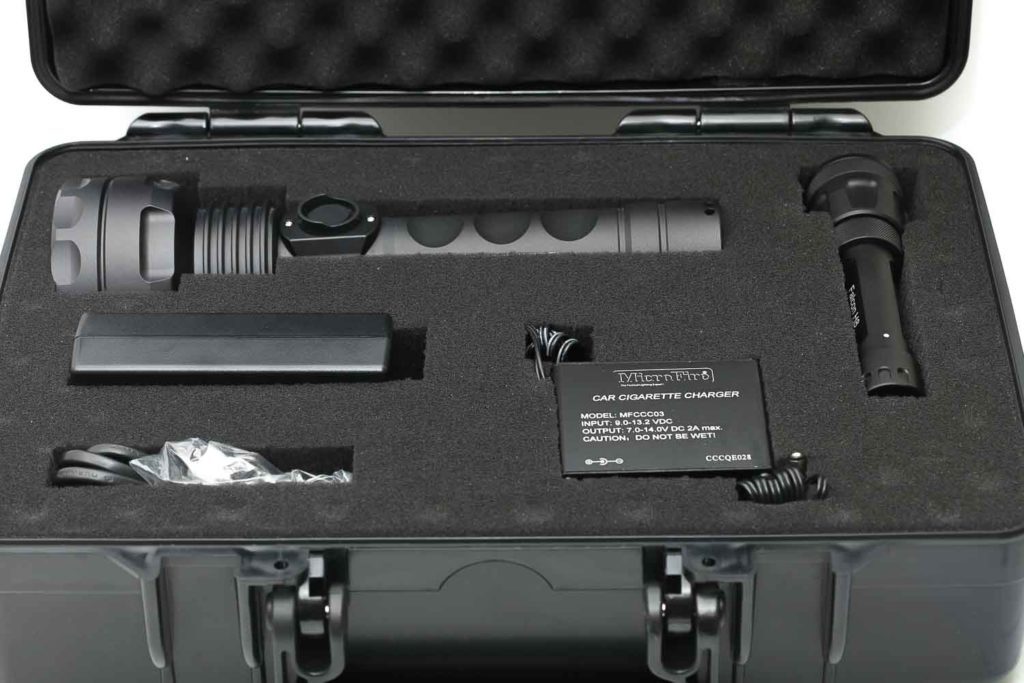
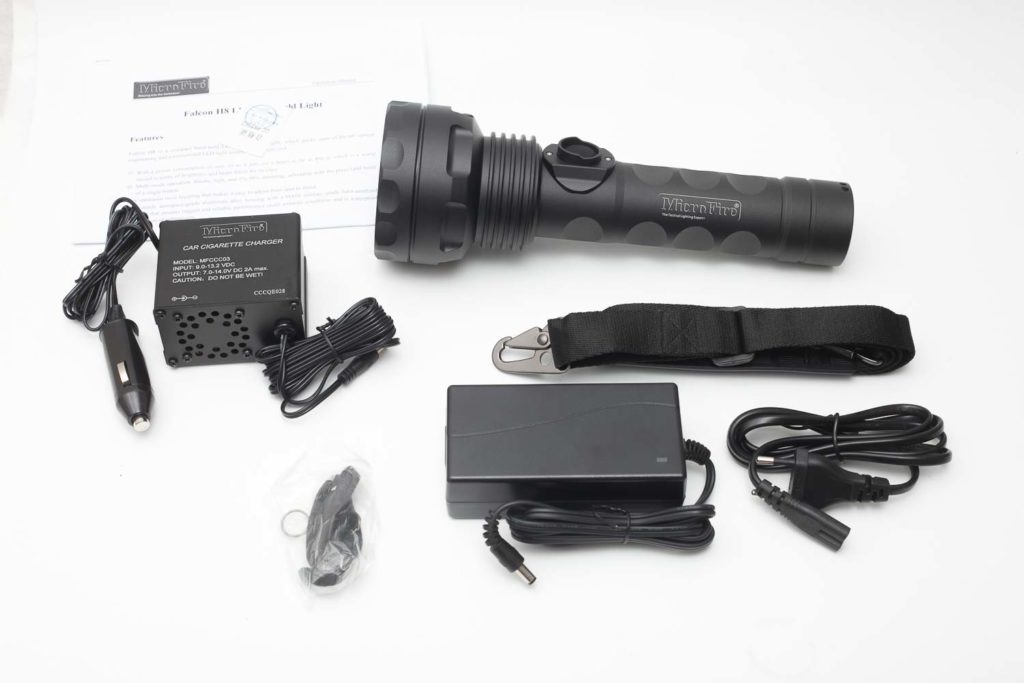
Handling of the light
Holding the H20 feel very different from any other flashlight I own. It screams military grade equipment. The manual states it’s aero-grade aluminum alloy, and I have no way of testing it, but it sure does feel different. It is definitely a big sized flashlight, but it still feels balanced in use.
One thing I really like is the large switch button. It’s so big, you can’t miss it, even when it’s pitch black. It has a ridge around it to protect from accidental activation. Using hand gloves, the H20 is still easy to operate.
In case you were wondering, it does tailstand, but with this type of light, you probably don’t need this.
Something that I am still wondering is the carry strap that was included. The strap has 2 clips, but it doesn’t fit the holes I thought were made for it. I then realized the steel rings are supposed to be used with it. But still I am missing an attachment point near the front of the light. I might have missed something, who knows. If you can see it in the pictures, let me know.
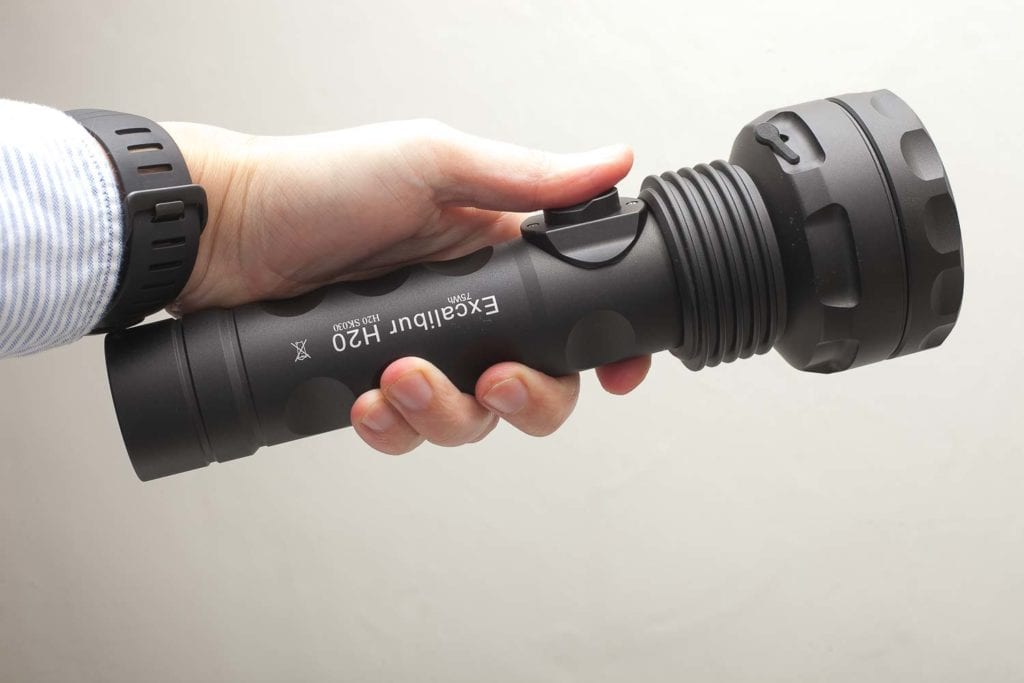
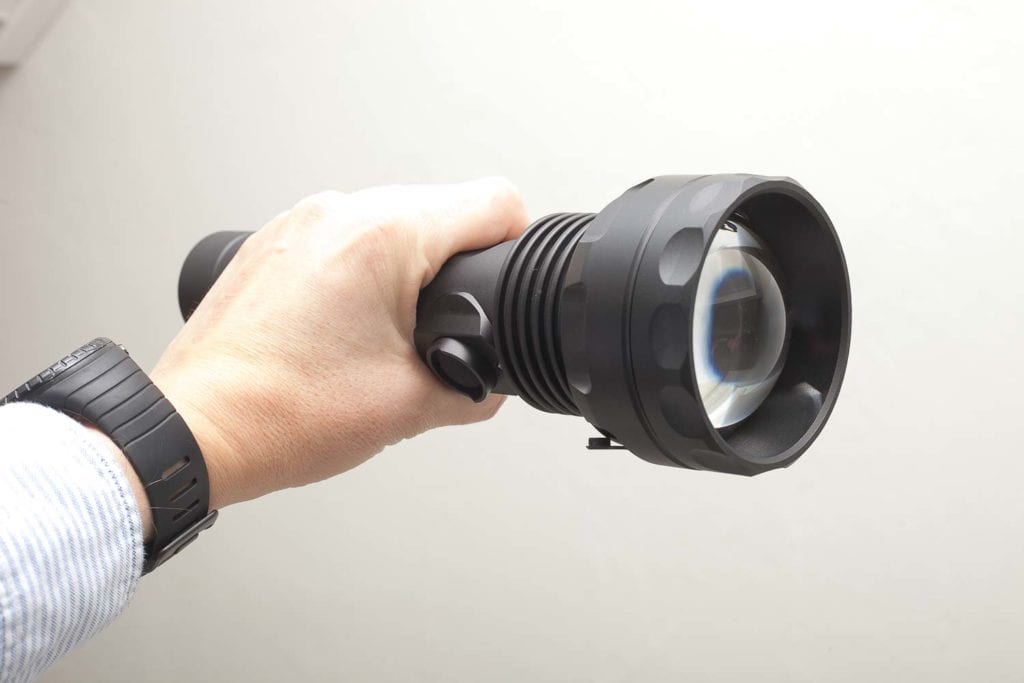
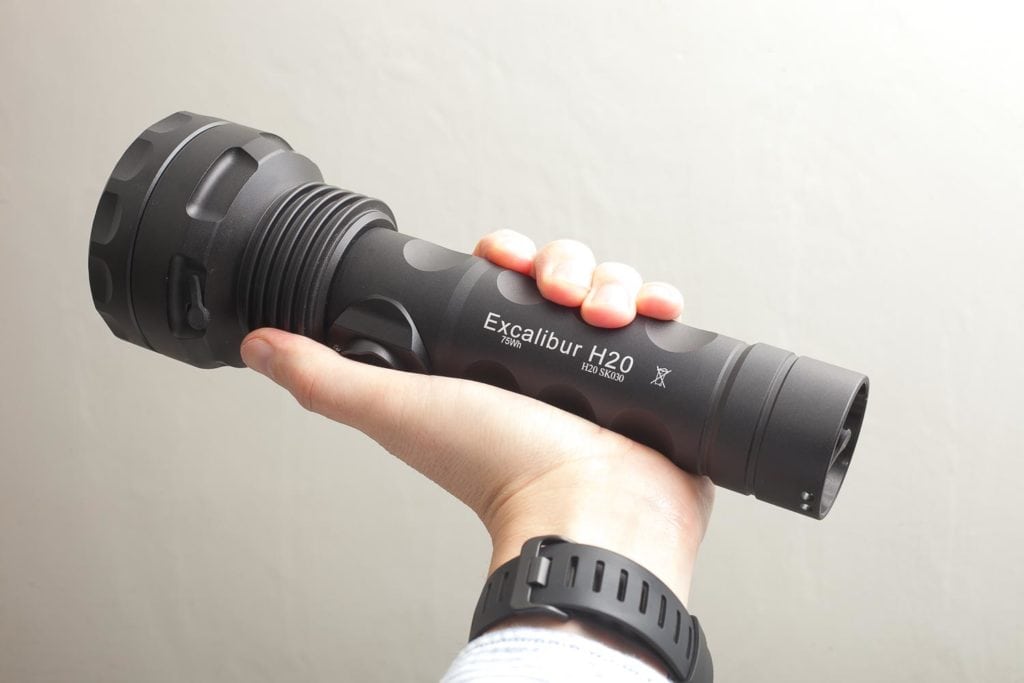
Build Quality, Knurling, Threads, and anodization
Its build quality is above my expectations. It would fit right in with military gear. Probably in the realms of Surefire and the like It has a very matte finish, and it’s not slippery at all. The manual states: hard-anodized finish per MIL-A-8625 Type III. And although I have no idea how to verify that, I just trust it to be true.
It even claims to be waterproof of up to 5 meters of submersion, which is hard to believe if you see that one hole in the body near the head. It’s a rubber cover that is questionable to keep water out. At least it doesn’t look it can keep water out. Please refer to the images below to understand what I’m talking about.
The case got delivered with a carry strap as well. The attachment points are different from what I expected. You basically slide 2 metal plates into the slots, and you’re done. No clips or anything, just metal plates.
For more details, have a look at the pictures below.
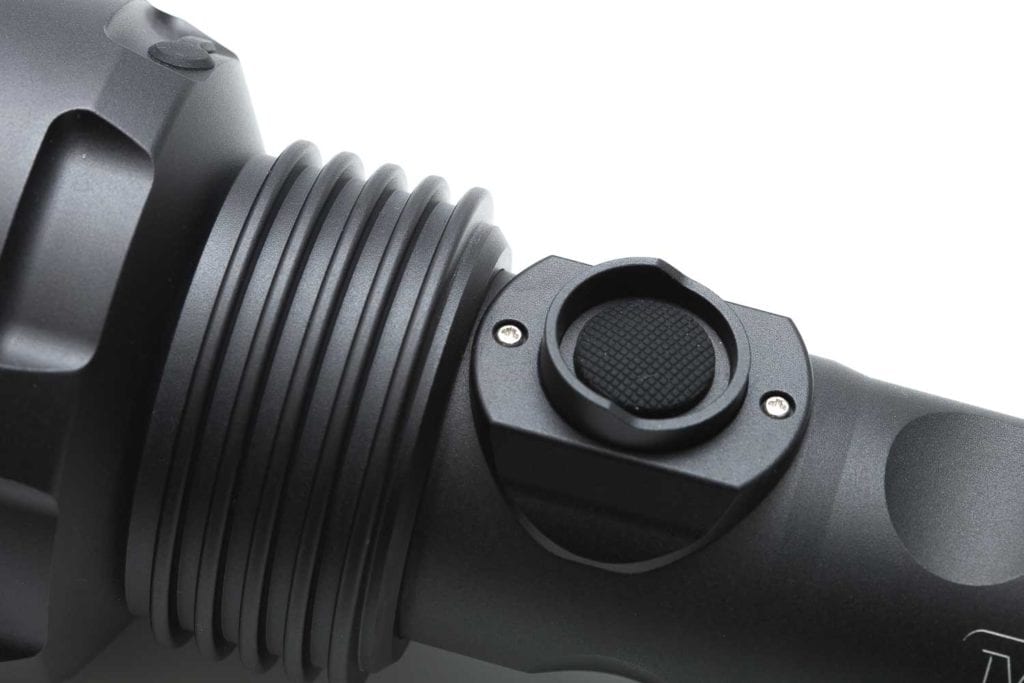
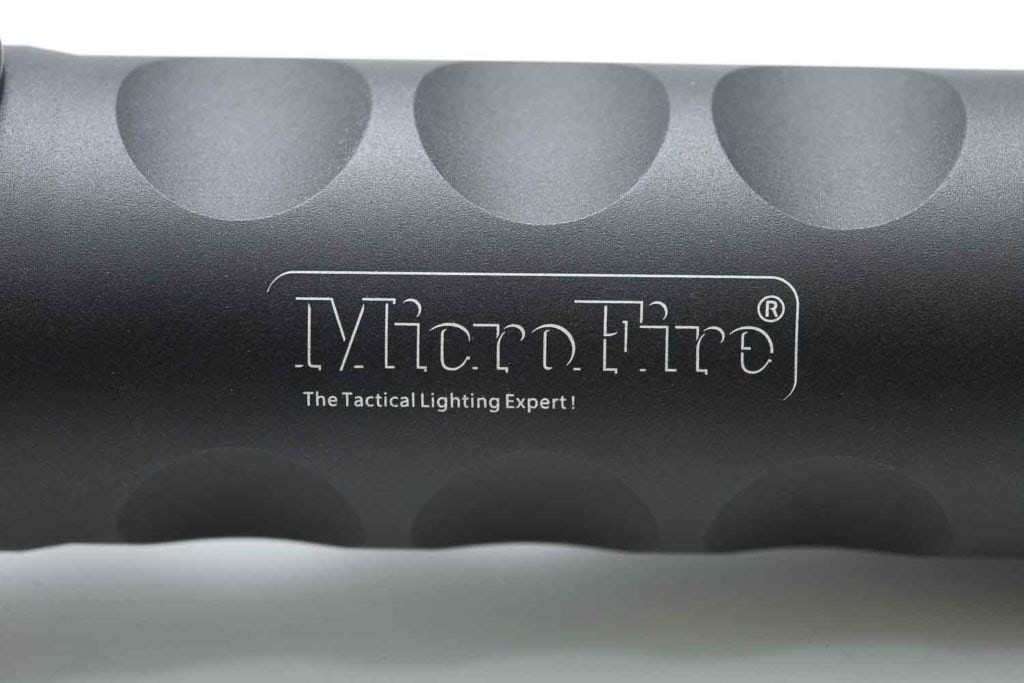
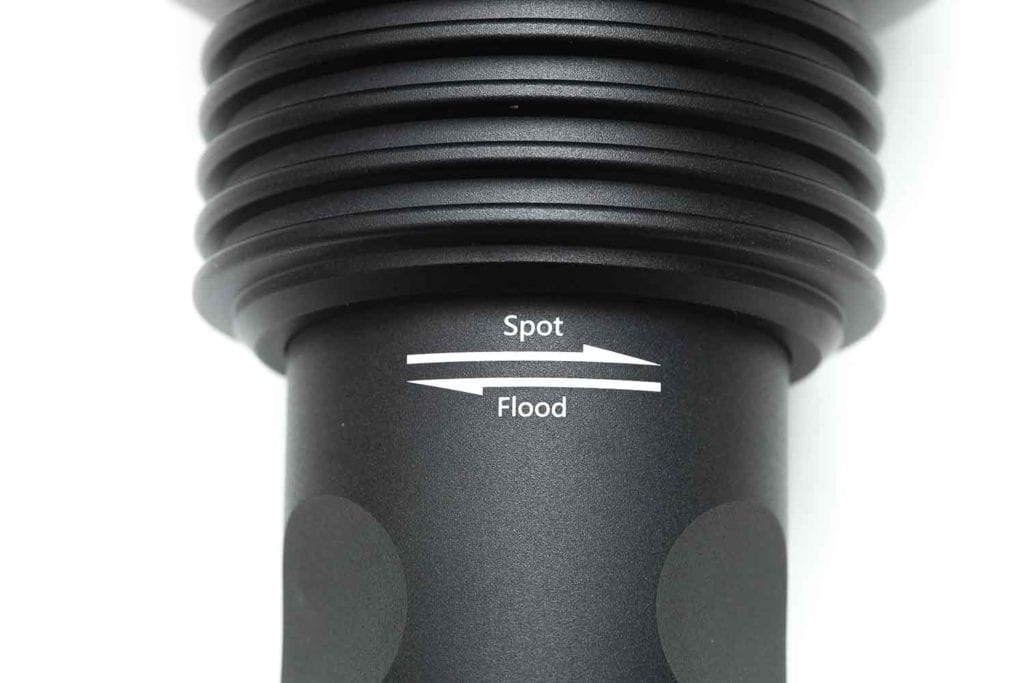
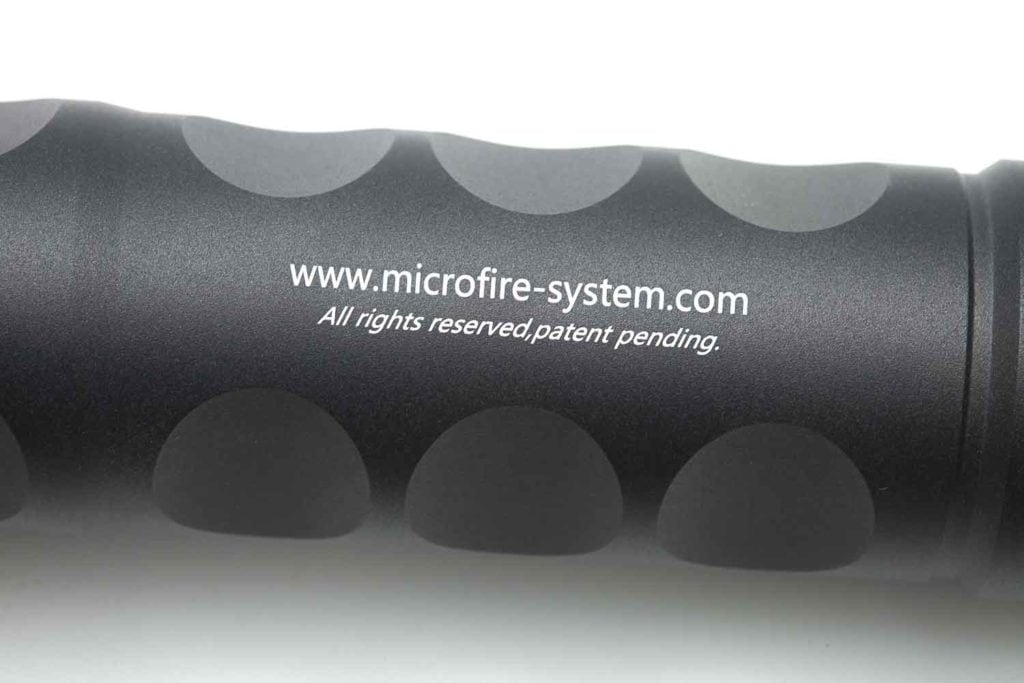
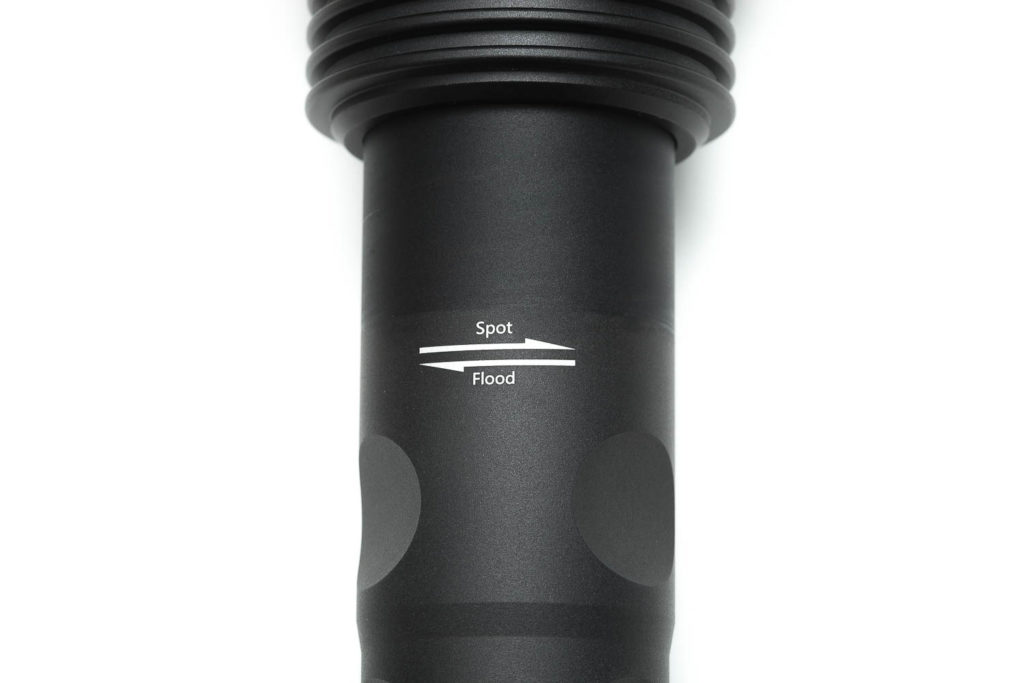
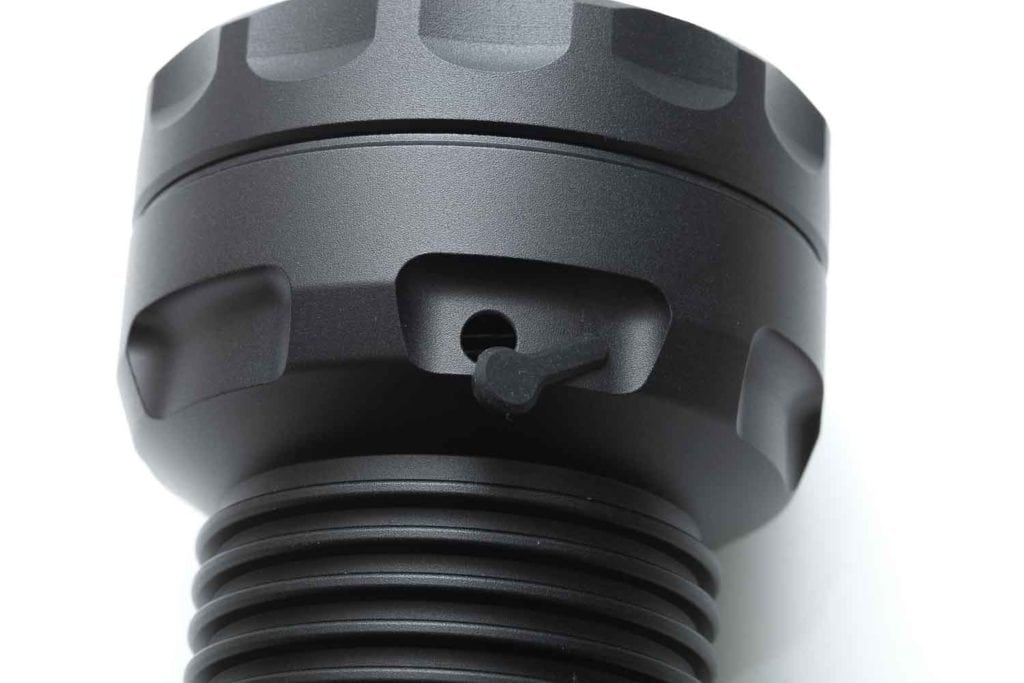
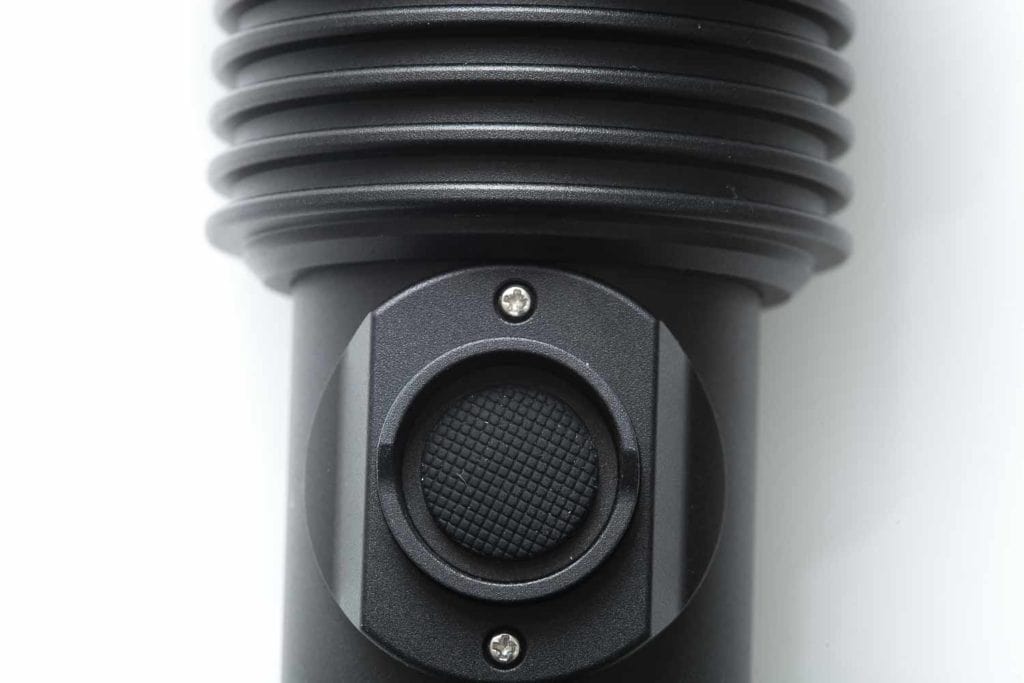
LED, LENS, BEZEL, AND REFLECTOR
Something I was wondering before receiving this flashlight was: how in the world can this type of flashlight reach 2 kilometers. It doesn’t look like the Lumintop BLF GT or any other long-range flashlight with a large head. But the Excalibur H20 uses a Convex lens with an LED that I think is an Osram White flat (W1) CSLNM1.TG. The bezel isn’t glued, so it’s pretty easy to remove. Behind the convex lens is a very thin O-ring, large enough to cover the whole width of the lens. The lighter ring in the center is actually a mirror type ring. It reflects the light back, and won’t get lost in the flashlight itself. That way, the focus system is very efficient and only loses a <10% of light! See the Lumen numbers below for the details.
Since the H20 is a zoom-flashlight, you twist the head to focus the beam. The widest beam has a divergence of 30 degrees and the narrowest of 1.4 degrees. That is a real pencil-like beam.
When the beam is at its widest, the beam color is whitish. When you start to tighten the beam, the hotspot changes from white to yellow to blue when totally focused. I will show you the beamshots below. It also depends on the distance between the flashlight and the object you shine at. Anyway, I hope the beamshots will do more justice than mine description.

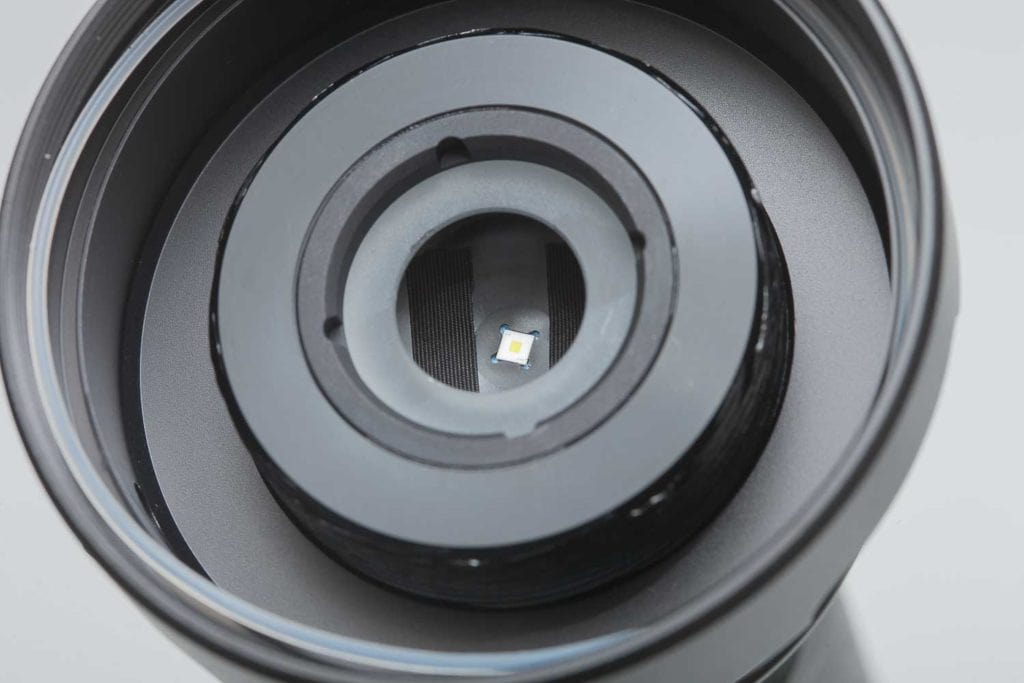
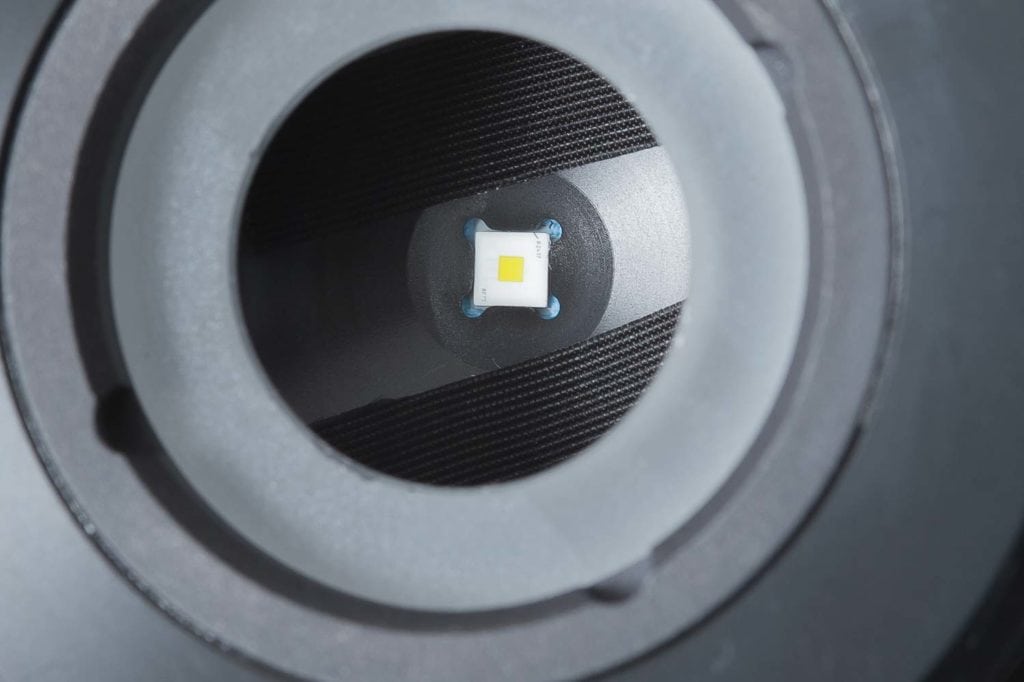
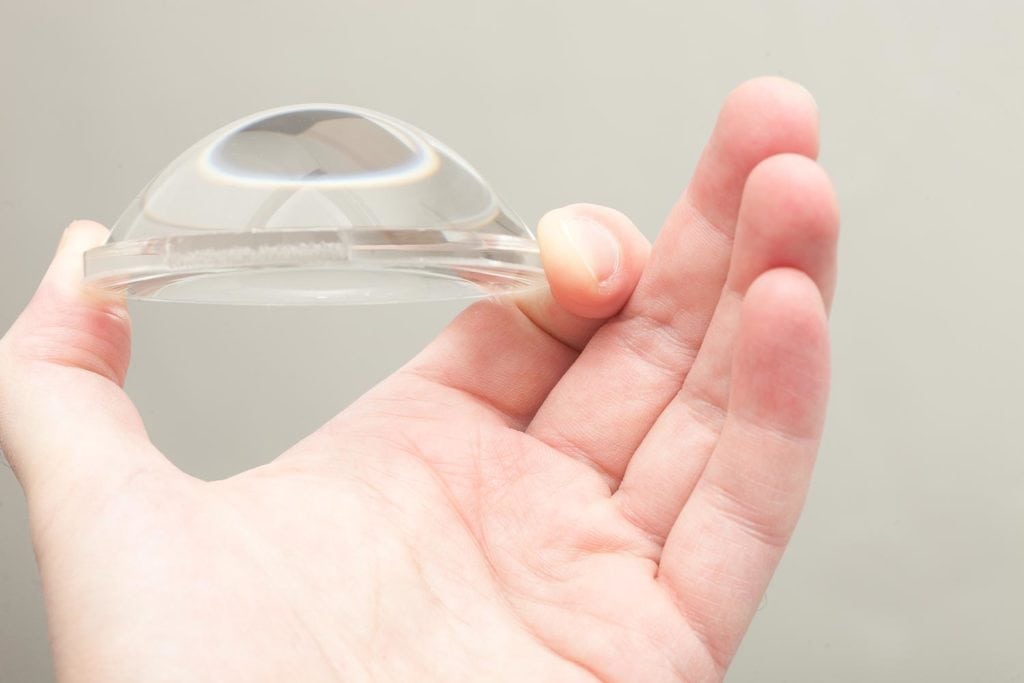
Dimensions
- Length normal: 257 mm / 10.1 ”
- Length focused: 287 mm / 11.29
- Head diameter: 87 mm / 3.4”
- Body diameter: 44 mm / 1.75”
- Tailcap diameter: 47 mm / 1.85″
Weight:
- Total weight: 1014.1 g / 35.78 oz
Long range flashlights
Size compared to a few of the best LED flashlight throwers. This is the best way to show its real size.
Image 1+2: Acebeam K75, Astrolux MF04, MicroFire Excalibur H20 (zoomed in and zoomed out)
Image 3: From left to right: Astrolux FT03, Noctigon K1, Speras T1 and MicroFire Excalibur H20
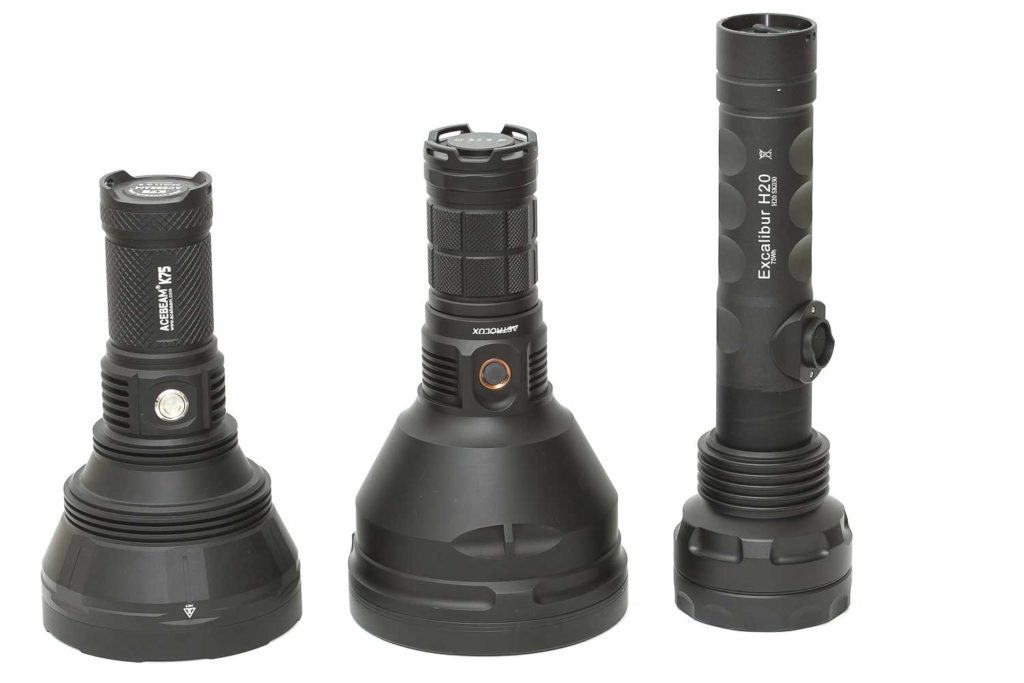


Driver & User Interface:
Without reading the manual, I didn’t understand the UI. It’s not very complicated, but it’s different from other flashlights.
Available modes:
- High
- Strob
- Customizable setting with 25 steps
From OFF:
- Single-click: High
- Double click: Just Off again
- Press and hold 2 seconds and release: Strobe
- Press and hold 4 seconds: Low/Moon
From ON:
- Single-click: OFF
- Double click: Just On again
- Press and hold 2 seconds: Just turns OFF
- Press and hold 4 seconds: Low
You can’t reach Strobe from when it’s on.
Custom Setting
- Low can be adjusted. You have to Press and hold the switch for 4 seconds or so, to enter Low Mode. Then press and hold the switch to ramp up the brightness in about 25 incremental steps. There is NO warning at the end of the ramp, and the flashlight will automatically step down in those incremental steps. The steps are relatively slow, but they aren’t memorized unfortunately.
Shortcuts:
- To Turbo: 1 click
- To Moon: 4 seconds press and hold
- To Strobe: 2 seconds press and hold and release switch (You have to release the switch to activate Strobe!
Mode memory:
- No, it will always start in High, or Low. If you select the desired output from Low, you can use it as long as the light is on. If you turn it off, you have to start over from Low again. I would have preferred a seconds output level with mode memory.
Blinky modes menu:
- Strobe. Only accessibale from Off by 2 seconds holding the switch and release. You have to release the switch or Strobe will not be activated.
Low battery warning:
- A solid green light at the tailcap shows the battery is running low. (the battery indicator will show every minute the battery charge). The light will shut off completely when it’s running low.
- 5 flashes – full
- 3 flashes – 50%
- 2 flashes – 25%
- Continous on – Below 10%
Lock-out mode:
- No
PWM:
- It seems to be there, but it’s pretty high. During use I couldn’t notice it.
Firmware / UI Conclusion:
The UI is a little different from other flashlights. And I would suppose they record the adjustable brightness, so the next time you use the 2nd mode, you will have your desired output.
And then have Low and Strobe only accessible from OFF, for example. Everybody likes a different UI for sure, but Anduril Firmware would not be advised for this kind of flashlight. Keep it simple, just like now, but make a few small tweaks to make it even better.
Batteries & Charging
Most flashlights charge batteries through a USB port. But the MicroFire Excalibur H20 gets charged with a 12V 4A power adapter. They also included a 12V car adapter so you can charge the flashlight on the road.
Please take note that the flashlight itself has no LED indicator during charge. That is what the power adapter is used for. It’s green when finished charging or when the plug is removed. And it’s red during charge. A full charge takes about 3.5 hours. Unfortunately, the Excalibur H20 doesn’t have a replaceable battery pack. I don’t think you have to care too much because of the long battery life. But in many circumstances, you’d love to continue using the flashlight and stick another battery in. If there is one thing they can improve this flashlight on, it is by having a removable battery pack.
Another thing I noticed is the backplate. The plate with the charge port is actually floating in the flashlight and stays in place by an o-ring. Yes, you can read that again. MicroFire told me this is better for its water resistance, but I doubt this, and in my opinion, they should have used threads+o-ring just like most other flashlights. It’s important that the plate stays in place, because water can definitely creep in.
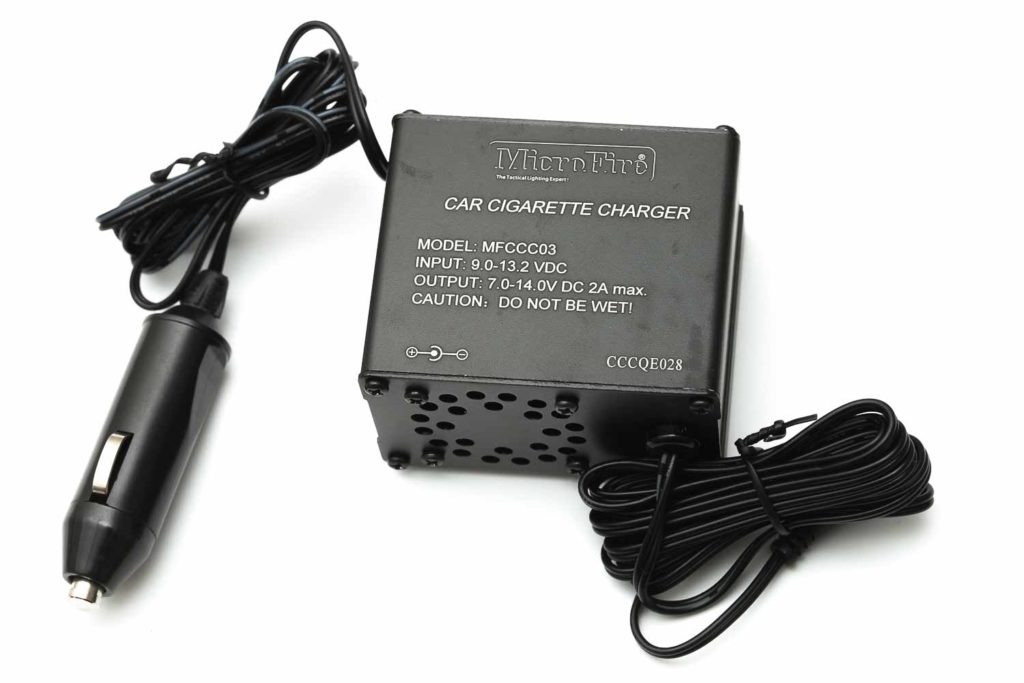
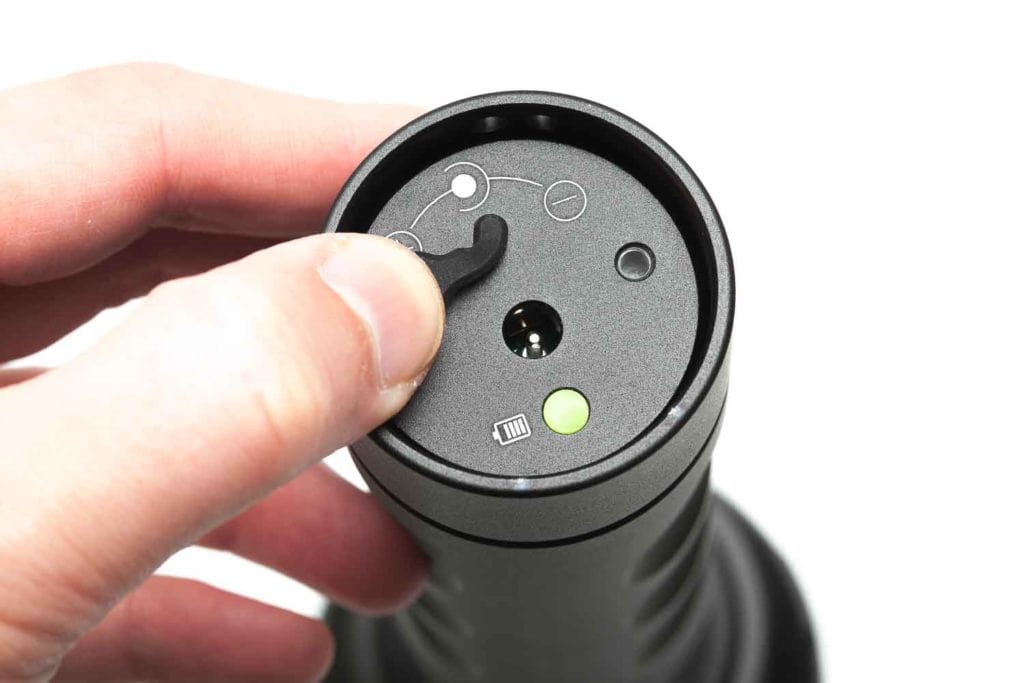
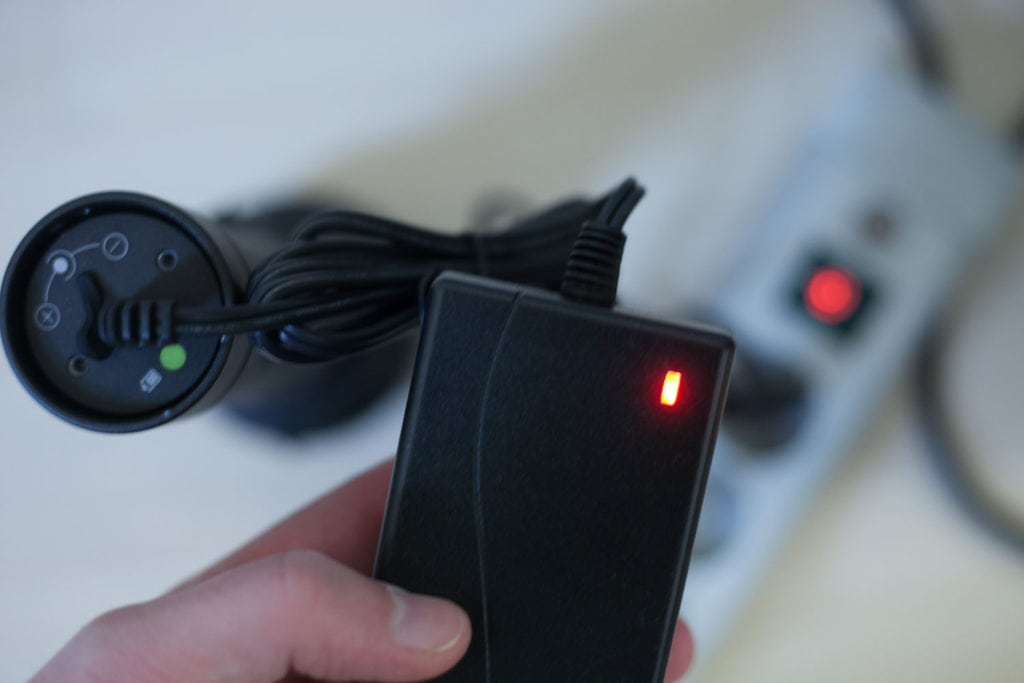
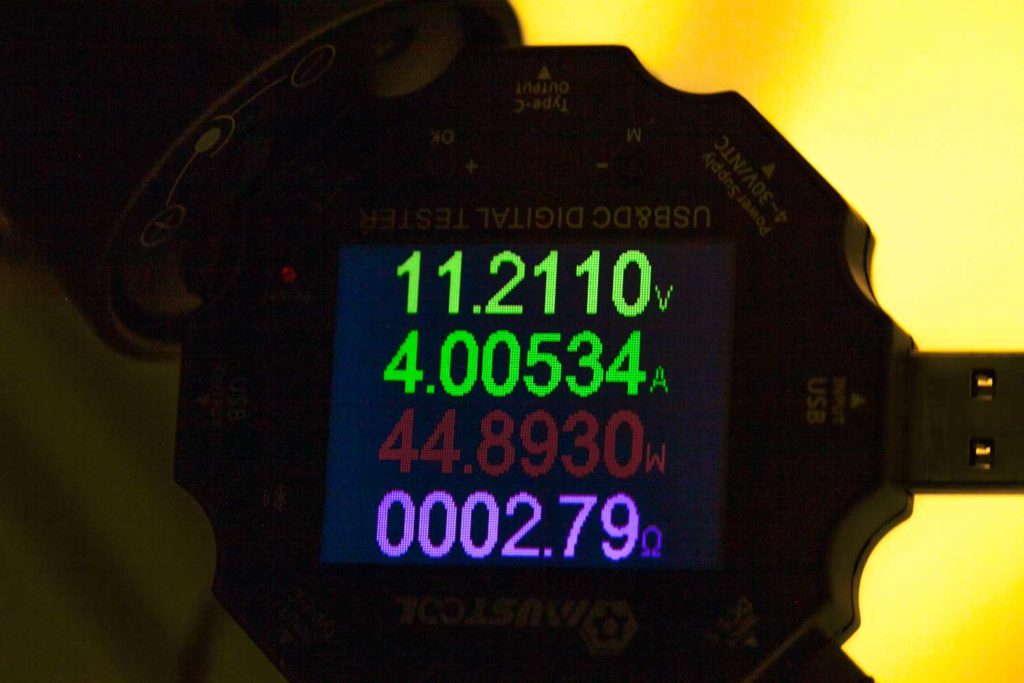
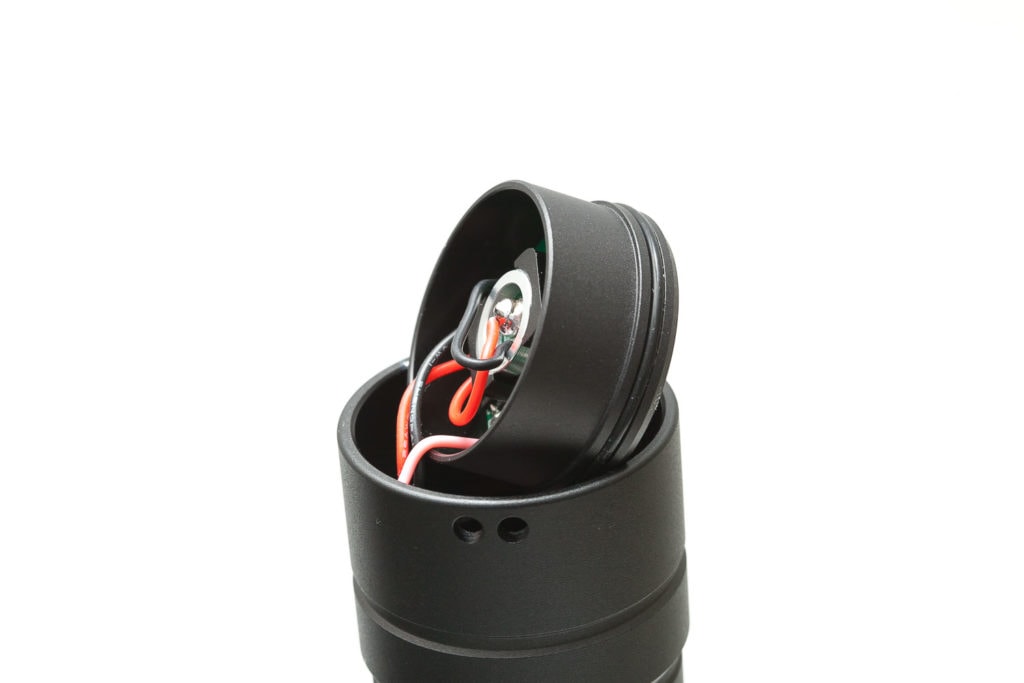
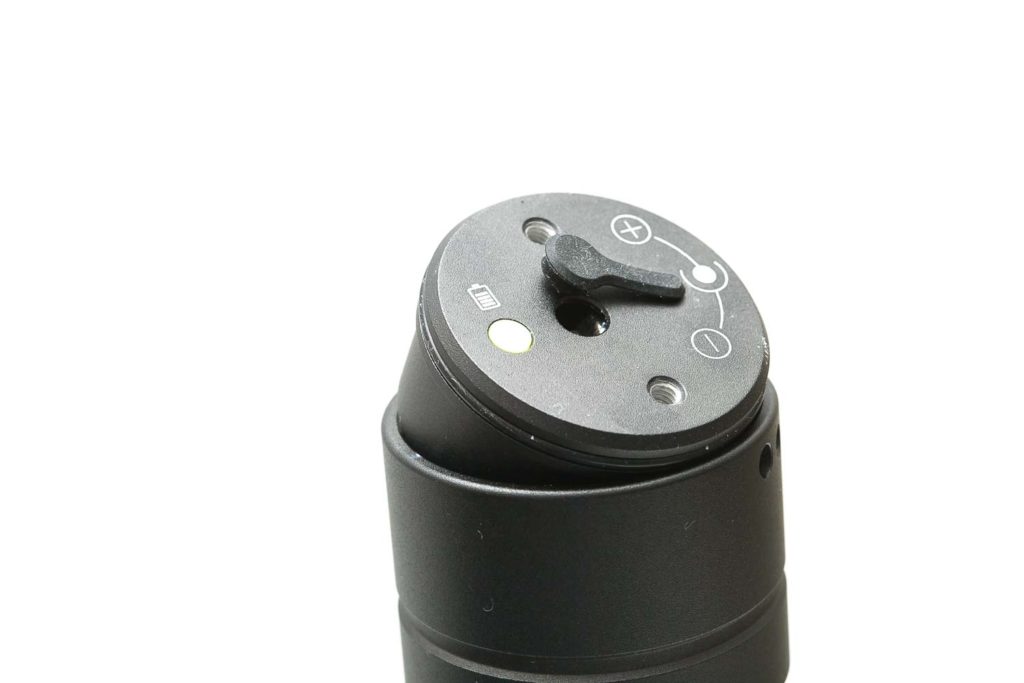
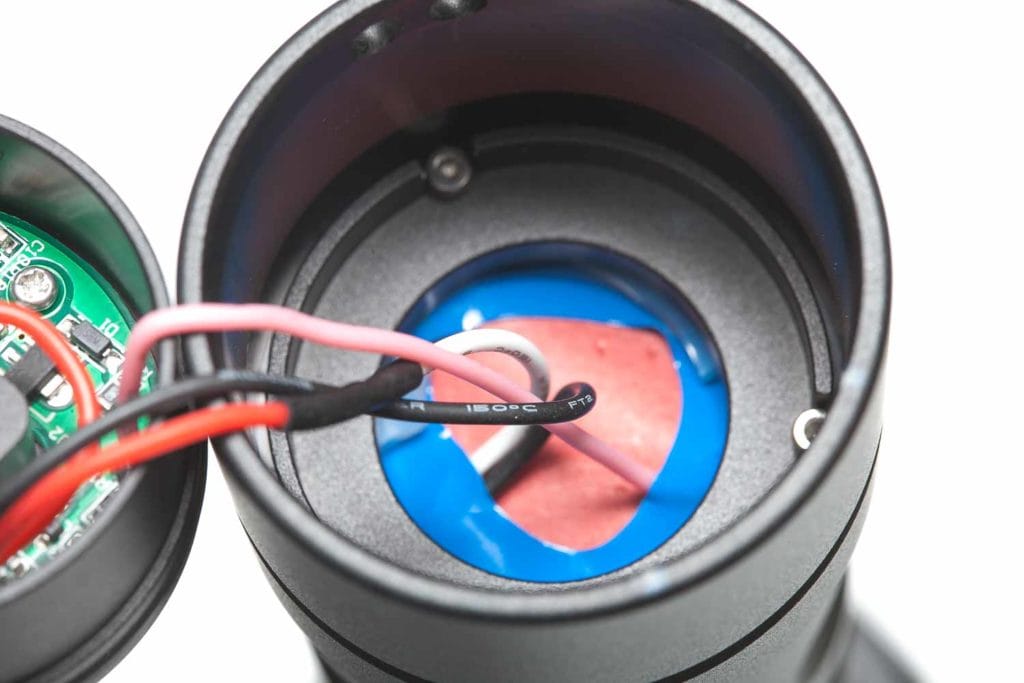
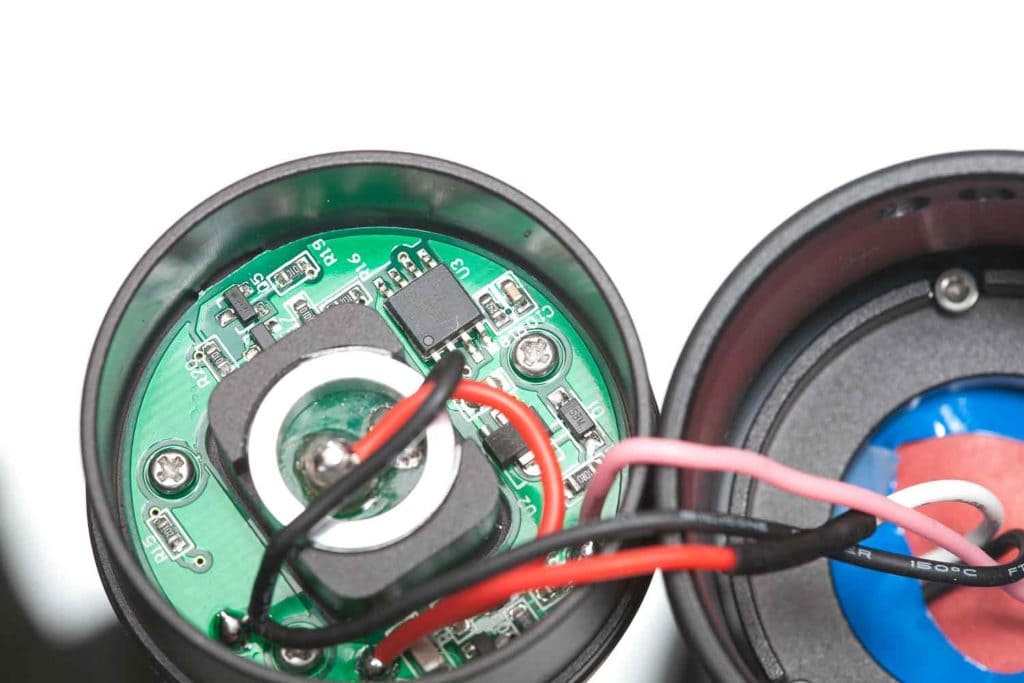
Performance
Lumen measurements:
All output numbers are relative for my home-made Integrating Sphere. It is set up with an Extech SDL400 Lux Meter for measurements including a Kenko PRO1D ND-16 filter. The base measurement is done with a Convoy S2+ that has been tested at 255 lumens.
| Mode | At turn on | 30 sec |
|---|---|---|
| High – wide beam | 420 | 408 |
| High – narrow beam | 390 | 385 |
| Low – wide beam | 13.34 lm | 13.34 lm |
| Low – narrow beam | 13.34 lm | 13.34 lm |
As you can see, this is not a high lumen beast, but it wasn’t supposed to be one either. It is made for throw, and that is what this light excels in. And if you own any zoomies, you will be surprised at how efficient their zoomsystem is. The difference I measured between the lumen output with the lens zoomed in, and zoomed out is only 7.6%. Most flashlights with a focus system lose 40% or more!
Runtime:
The runtime test was done with the 50cm integrating sphere, including the Kenko Pro1D ND-16 filter and Extech SDL400 data logging Lux Meter.

This runtime is what you would prefer in a flashlight like this. No drops and very stable output for more than 6.5 hours. And this is the highest setting. The lowest setting will be good for a few days!
Throw Measurement
Measurements were taken outdoors at 20 meters with a professional Hagner E4-X Lux Meter.
| Setting | Candela | Meters | Yards |
|---|---|---|---|
| Focused to max | 524,000 cd / 524 kcd | 1448 | 1583 |
| Manually adjusted focus | 1,196,000 cd / 1.19 Mcd | 2187m | 2392 |
| Lowest mode, manually best focus | 56,000 cd / 56 kcd | 473 | 518 |
You can see that the max focus doesn’t necessarily mean the best focus. It had about half of the throw measured at 20 meters than manually adjusting it. It is very possible I could get a bit more than 1.19Mcd, with manually focusing. Even at the lowest mode, the throw was still 56000 cd. But the beam was very weak. You can see that the max beam distance is more than 2 kilometers and almost 2400 yards, which is 1.36 Miles
I compared the data with some LEP flashlights, and this is the result. You can see it’s not as intense at startup, but the runtime is just insane. After 1 hour it’s likely performing the same in terms of intensity as the top-performing LEP flashlights. Of course, their batteries are much smaller, but it’s important to note the difference. BTW, that little bump at the end of the runtime isn’t visible in the data, so I assume Google Sheets is doing something strange there!

Beamshots
For the following beamshots I used a Canon EOS 5D Mk2 and a 100mm lens. manual settings: ISO1600, .5sec , F4, 5000K. Pictures were taken on different days with more/less darkness.
The first tower is 650 meters / 710 yards away, the second tower is about 450 meters / 492 yards away. You can also see the last 2 pictures where I focused completely in, and the other picture I manually adjusted the beam to one of the highest intensity.
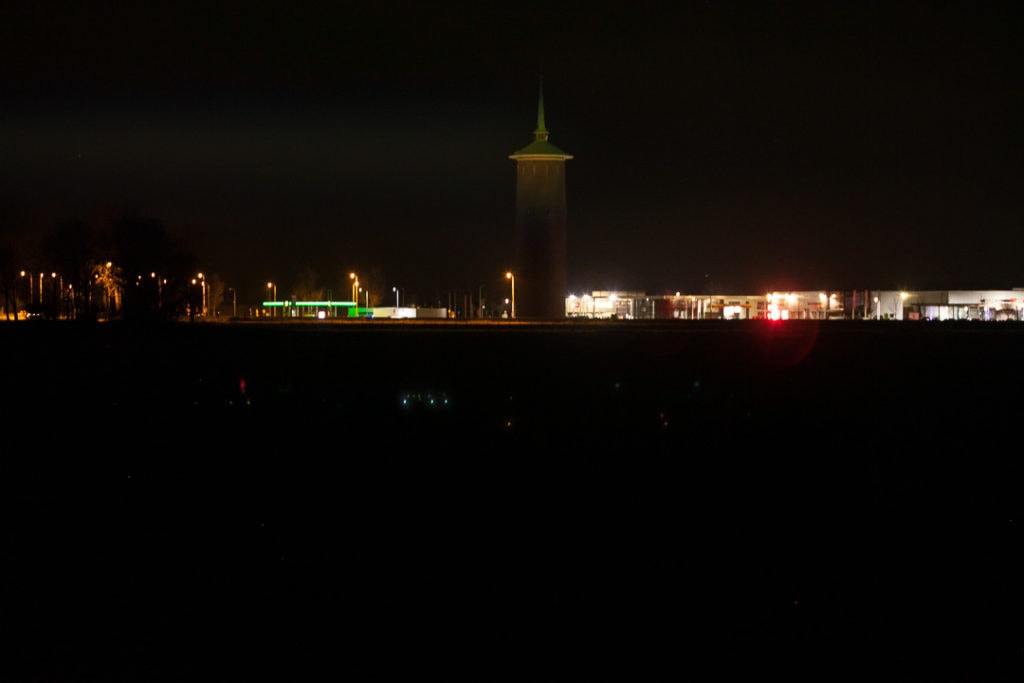
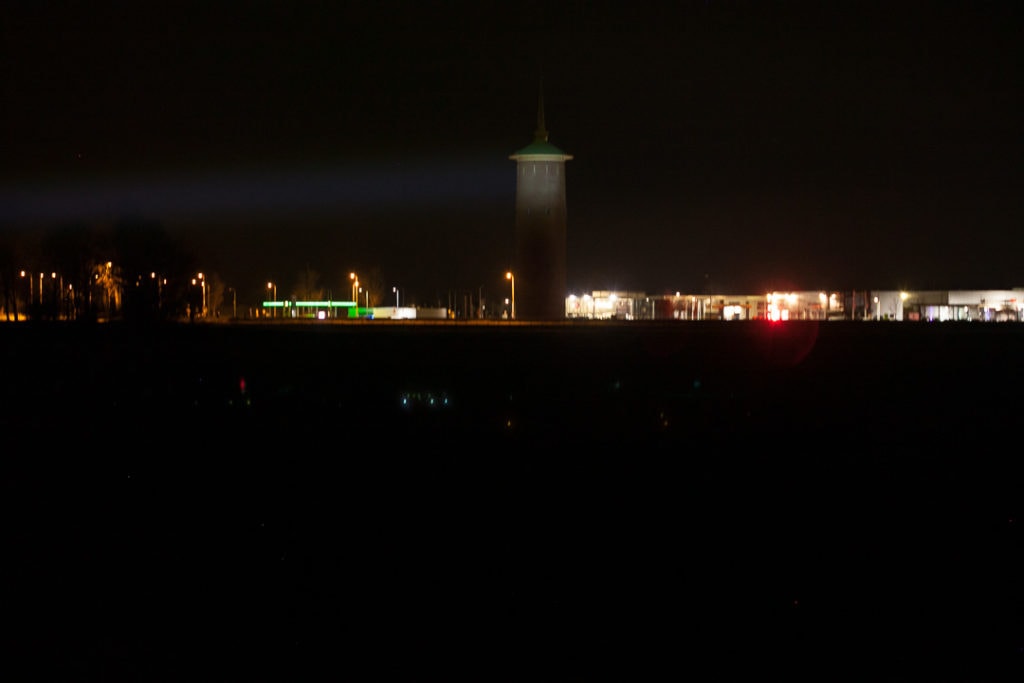
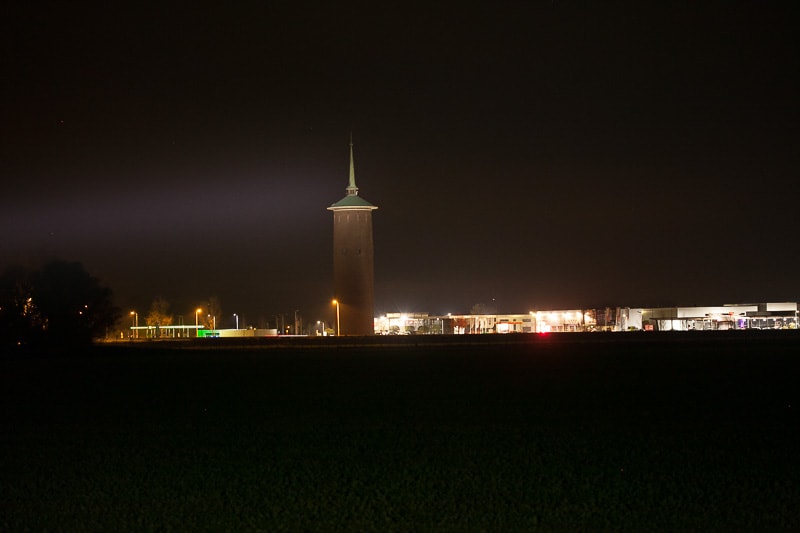
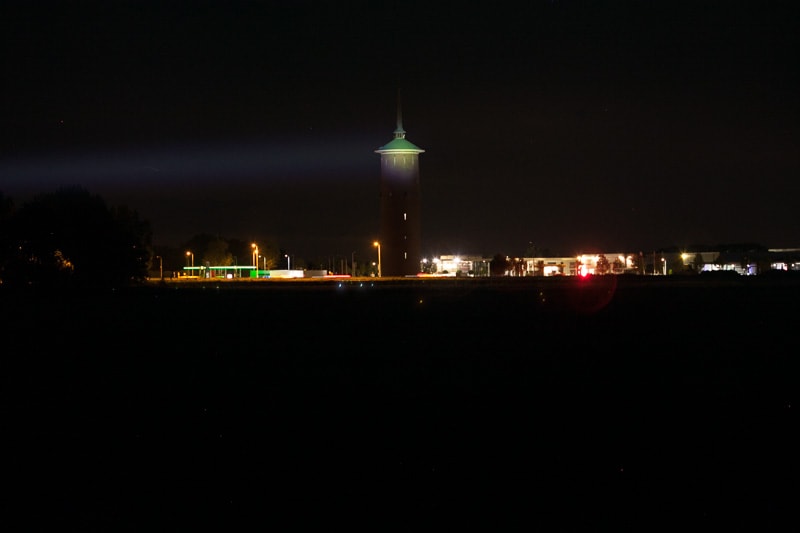
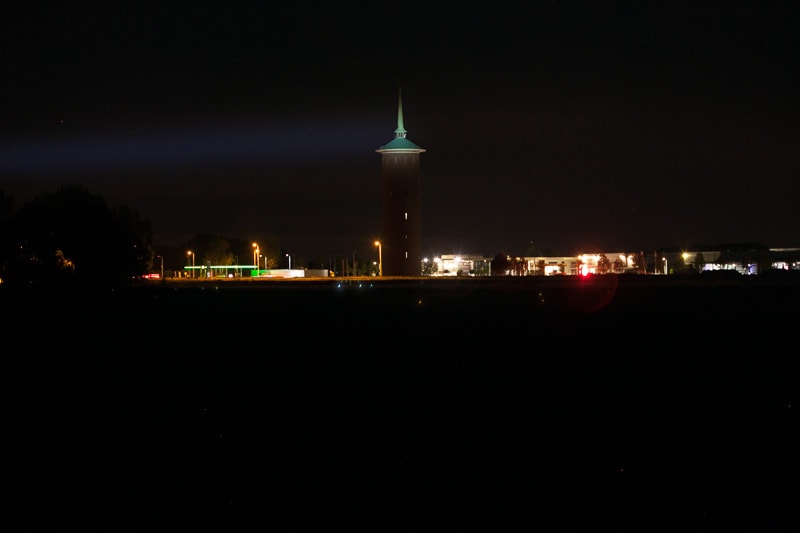
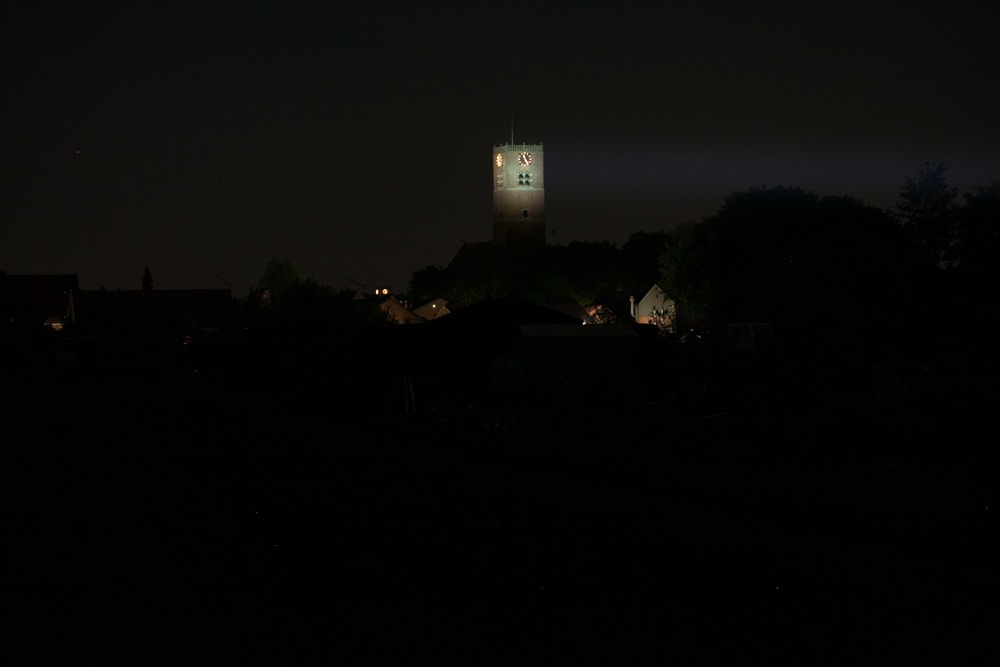

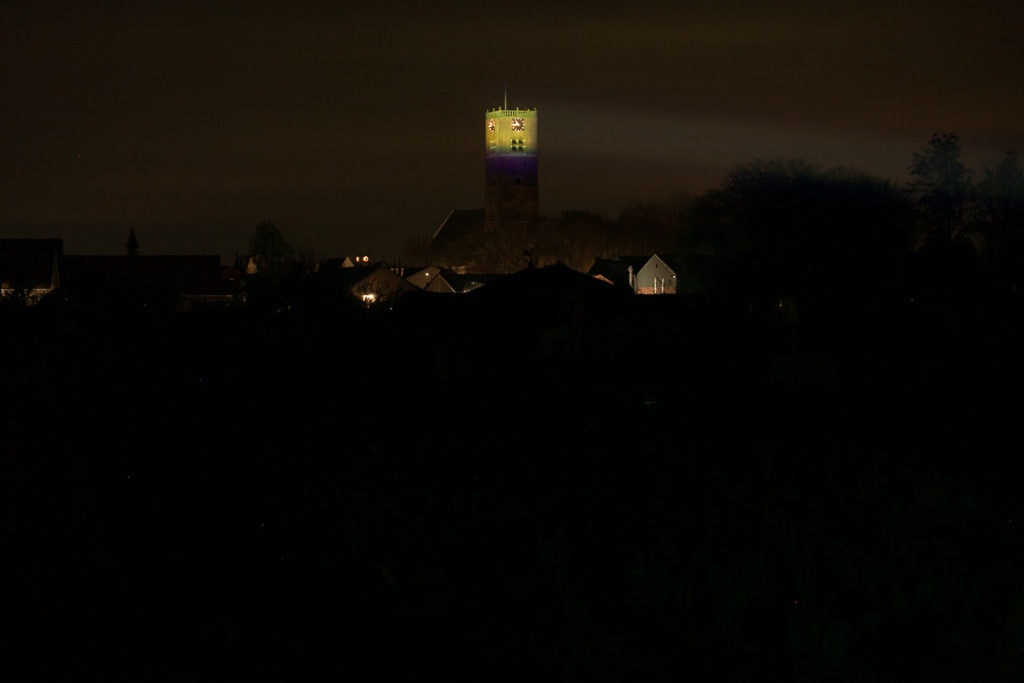
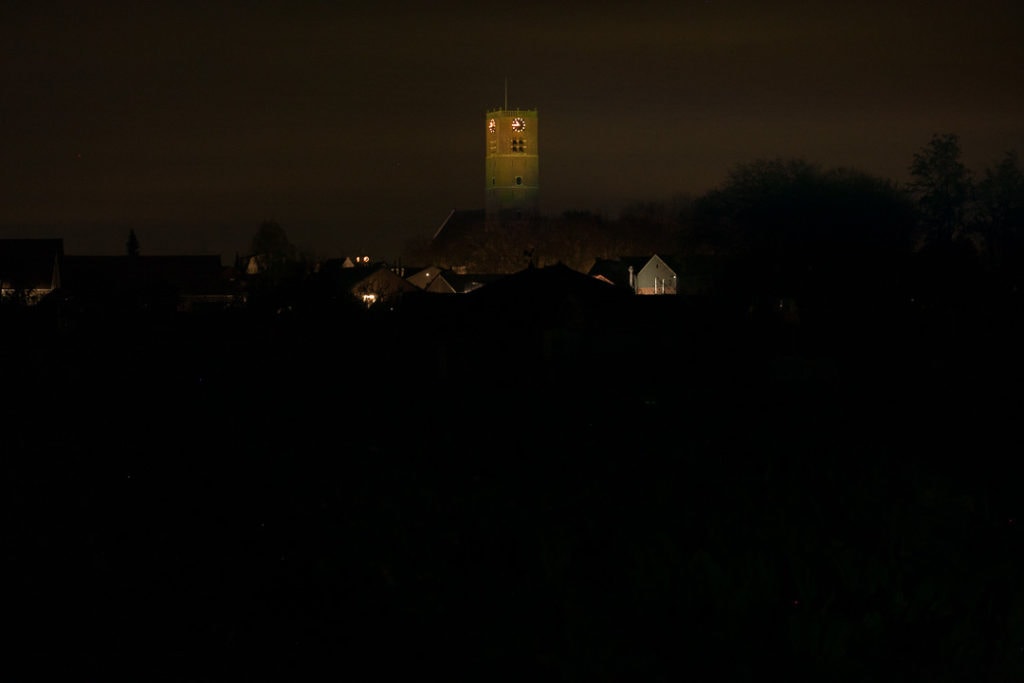
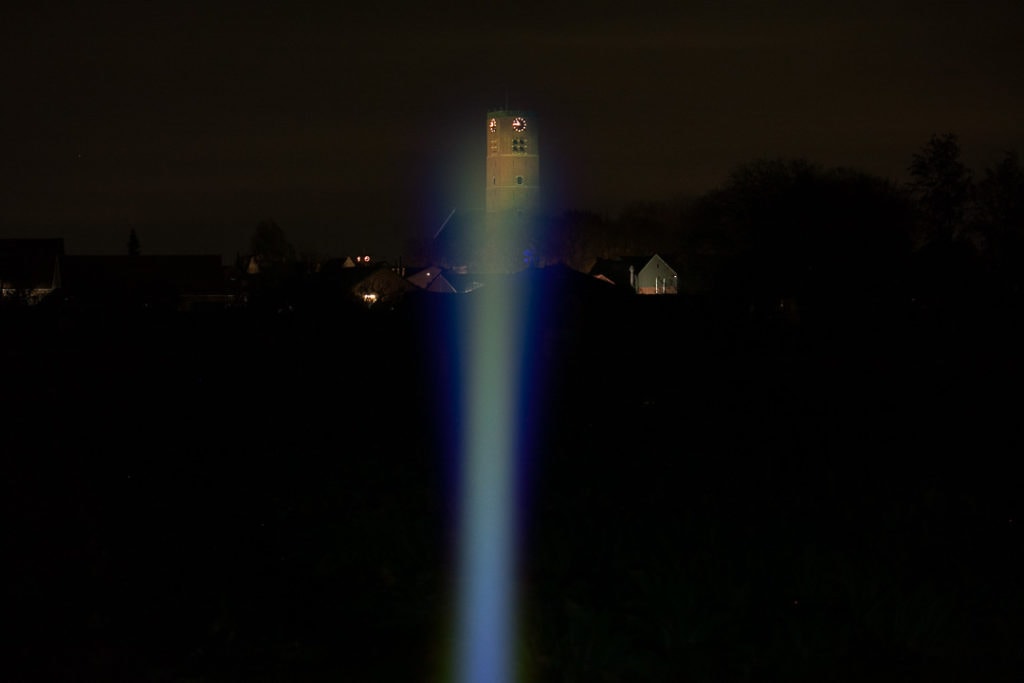
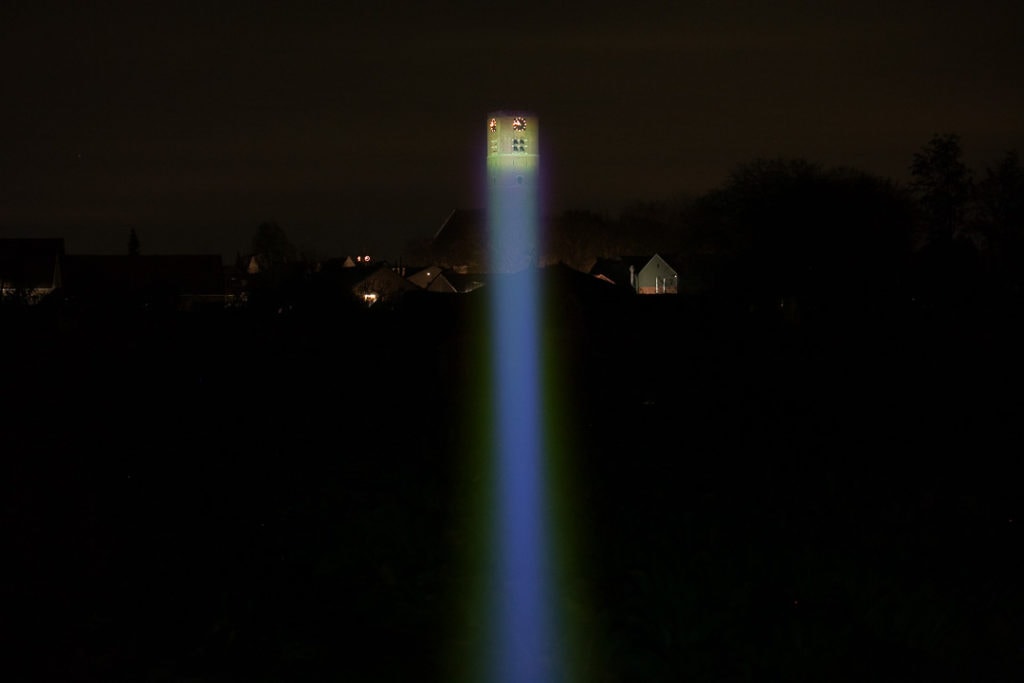
Disclaimer: This flashlight was sent to me for review at no cost, by MicroFire. I have not been paid to review, nor have I been holding back on problems or defects.
OVERALL CONCLUSION
Pros
- Throws extremely far
- Very efficient zoom system with a very small percentage of lost light while focusing the beam
- Extremely long runtime
- No significant drop in output from the start
- Hard carry case included
- Includes a 12V car adapter
Cons
- The backplate isn’t screwed into the light
- 5 meters of water immersible is questionable
- Non-removable battery pack
- UI is simple, but an easy 2nd output would have been great
- The focused hotspot changes color (But that is the nature of focusable flashlights in general)

4 stars: ★★★★
It’s not often that I review a flashlight of this caliber. The MicroFire Excalibur H20 is a light designed for tactical applications, like the Military, Police, etc. Its performance is outstanding. The only 2 things are the battery pack (and backplate) and the UI. In most cases, you’d probably only use High mode anyway, but a second mode with mode memory would have been preferred. Right now the ramping option isn’t very helpful unless you use the flashlight continuously for many hours without changing output. Okay, the third is the beam color when zoomed in/focused.
MicroFire Excalibur H20 information
Microfire decided to close their online store. You can still see details on their company website below:
1lumen selects and reviews products personally. We may earn affiliate commissions through our links, which help support our testing.